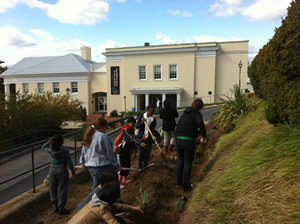Guest post by Karen Kappert
Many of us are familiar with the concept of “farm to school,” a practice becoming more and more popular with school districts trying to increase healthy eating, stabilize their local economies, and promote more sustainable food to table practices. While most of us associate this idea with elementary schools, some universities in Virginia have been working hard to initiate their own Farm to University programs.
Bridgewater College – Bridgewater dining services has adopted a FarmSource program that attempts to source their food from within a 125-mile radius of their campus from local growers and producers.

A sign showing where one of the campus gardens is at EMU. Retrieved from http://www.emu.edu/sustainability/campus/
garden-compost/
Eastern Mennonite University – EMU takes sourcing their food locally to a whole other level with their creative “edible campus.” Their landscape is no longer just pretty flowers; their campus is now lined with trees that bear fruit, flowers that bloom into squash and stalks of asparagus sprouting along walkways. Their dining halls also incorporate local produce either from EMUs own campus community gardens or sourced from near-by farms.
Ferrum College – Ferrum sources their food locally, and very recently has formed a partnership with Riverstone Farm, an organic farm less than 20 miles from Ferrum’s campus, who will provide many of the college’s salad greens. Ferrum also has a “Farm to Cafeteria” program that includes a garden on campus that provides fresh veggies to their dining halls.
George Mason University – GMU spends 9% of their food budget towards local food, which the university defines as within 250-miles of campus. However, it is estimated that most of that food comes from within a 75-mile distance! GMU has also recently committed to purchasing 100% of their milk and bread locally and is part of the Virginia Green campaign.
James Madison University – JMU has a local purchasing initiative and is participating in the Virginia Green campaign – both of which promote the use of foods sourced from Virginia. JMU offers a map showing where the farms from which they source some of their fruits and veggies are located and has recently developed an herb garden to be used for one dining hall.

The herb garden on Mary Balwdwin’s campus. Retrieved from http://www.mbc.edu/news/2010/11/08/new-student-corps-sees-fruits-of-its-labor/
Mary Baldwin College – Mary Baldwin has many sustainable initiatives, one of which is the purchasing of local foods to be incorporated in the meals provided on campus. A student-run organization has also developed an herb garden on campus.
University of Virginia – UVA is committed to sourcing their food from within 250 miles of Charlottesville, Virginia, where the university is located. They are also committed to purchasing and using seasonal food and are part of the Virginia Green campaign. A unique aspect of UVA is their utilization of the Local Food Hub, which is a distribution organization in Charlottesville that pulls the produce of many family farms together in order to sell large amount of products to institutions such as UVA.

Virginia Commonwealth University – VCU purchases 28% of their foods locally, defined by the school as within a 200-mile radius from campus. VCU is also part of the Virginia Green campaign.

Kentland Farm at Virginia Tech. Retrieved from http://farmsandfields.wordpress.com/local-vendor-profiles/
Virginia Tech – VT has a “Farms and Fields Project” which is a food venue at one of the university’s dining halls that provides students with local foods. Their blog also highlights VT’s other efforts to incorporate local into other dining facilities. VT has their own farm, called Kentland Farm, that provides thousands of pounds of food to the dining halls. The Meat Science Center of Virginia Tech has also teamed up with dining services to provide meat for the dining halls that was processed on campus. Local for VT is defined as within a 250-mile radius and VT’s use of local food is 1.6%.
Washington & Lee – W&L is part of the Virginia Green campaign. The university purchases around 25% of their products locally. Each year the school hosts a Harvest Dinner to make students more aware of the local foods and to develop their relationship with their food producers. W&L also has a campus garden.
William & Mary – W&M defines local as within 250-miles of their campus. The college has a campus herb garden and now all residential dining halls contain locally produced salad greens in their salad bars.
Eastern Mennonite University and Virginia Tech University are highlighted dark blue for their original and creative attempts of incorporating local food into their dining systems. But all of these universities in Virginia – and even more that aren’t listed – are inspiring with the way they are working hard to keep money in the local economy while also supplying our students with local, seasonal food.
By: Karen Kappert
Buy Fresh Buy Local Intern, Virginia Cooperative Extension Student, James Madison University, Public Health Education
